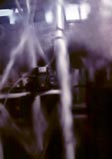Next
Wave Festival Catalogue Essay
©
Copyright 1994 JON McCORMACK

|
|
 |
|
I am one of the first of the computer generation. I have used a computer almost every day of my life since secondary school. I spend more time interacting with machines than I do with most of my friends. Many people consider the digital computer as a benign tool like a car, a hammer, a sewing machine or a word processor. I don't see things this way. The computer is a window. It opens onto many things, many places and many ideas. There is no reason to be constrained by the limitations of the physical world we inhabit. It is the medium for the realisation of ideas, objects and expressions with a corporeal fidelity that has never before been possible. It requires no financial justification, it passes no judgement, it has no point of view. I am the explorer and it is the ship I sail on to journey this new world. Perhaps it has the potential to be the ultimate creative medium. You might expect that my ideas about the world are introverted around the machine, in fact the opposite is true. The computer has shown me things about the world that I could not have known, understood or seen any other way. I see and appreciate nature in a fundamentally different way than before. My perception and understanding are expressed through the machine: it is not about the machine (which is extensively inert). I use a computer for the simple reason that the work I create with it would not be possible in any other medium. |
|
The
basic way in which computers operate has essentially been the same since
the 1950's This idea
of experimentation through interaction is extremely powerful when applied
to visual computing. Interaction between mind, computer and (responsive)
image is the inspirational process dubbed
computational synergistics. Very little commercial software for computers supports or understands this way of working (why is it that so much 'computer art' looks and feels the same?). Inevitably, to really exploit and understand the process I am referring to, you must write your own software. This puts you on more basic terms with the machine, it allows the direct implementation of ideas, as opposed to interpretation through another's constraints. I don't wish to sound overtly didactic in this statement, it's simply a personal observation. With the advent of mechanical reproduction the nature of the image changed. Digital images offer perfect reproduction and thus remove the notion of location and of the 'original', completely. With the possibilities of image synthesis (photorealism and beyond) the image looses all it's special qualities. This makes the image meaningless (already in our society, most images are meaningless). Computer synthesis means there is no reason for images to be some fixed static entity, based in terms of creator, creation time and location. Images will adapt and change based on direct or indirect interaction with the viewer. The future of computing (and of our society) is post-visual –it's based in experience. |
|
"What will die with me when I die, what pathetic or fragile form will the world lose? The voice of Macedonio Fernández, the image of a red horse in the vacant lot at Serrano and Charcas, a bar of sulphur in the drawer of a mahogany desk?" I think of Borges and his mahogany desk, his anguish over time, space, death and the infinite. My ultimate rational in using a computer to explore the world around me, is to better understand my own mortality. At one level, there is potential for a higher degree of immortality than was previously possible, especially if we are to believe in the artificial intelligence myth of the supra-human, self aware machine. However, (in these times at least) to accept this would be pretentious, arrogant and uninformed. In a way, as an algorithm executes, it is an ultimate truth. It is free from indecision, mistakes, emotion and opinion. Of course, as a programmer I carry my bias into any program I write. But the whole is greater than the sum of the parts (or is it a type of creative enzyme?). Perhaps it's just a modern form of archetypal cushion –my way of coping with these enigmas. Like the red horse, these are personal memories and discoveries that I treasure. As with any system of beliefs, the world doesn't change because you describe it differently. It is oblivious to classification, theory and understanding.
Ultimately then, you don't have to be right, you just have to be sure. |
||